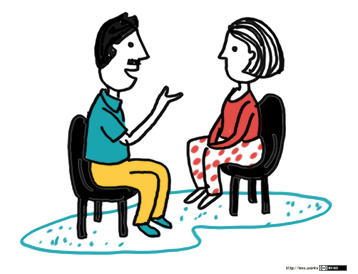Coaching
Coaching means that an experienced Coach will work closely together with an organization to improve the organization’s product development. This usually involved shortening feedback loops and focusing on improved quality. This faster feedback cycle leads to benefits such as higher productivity and more flexibility.
A LeSS adoption chance of success is dramatically higher when the organization ensures the appropriate level of coaching. Many organizations think that reading a book or a short training is enough while adopting LeSS. While there are certainly cases where that worked, most cases it doesn’t and a LeSS adoption needs more active coaching.
Internal vs External coaching
Coaching doesn’t have to be external (from outside the company). It is possible, though very hard, to set up an internal coaching network which supports the LeSS adoption. Setting up an internal coaching network often fails because (1) being a coach internally is often not a job which the potential coaches want to pick up… as they like working on the product itself, (2) coaches often lose touch with the reality of the product development as they don’t practice enough Go See
Warning: If you do set up a coaching group in your organization, ensure to not just staff it with the “left-over people” who happened to be available. That will fail.
Coaching can be internal, but we do recommend to also involve at least one external coach who is there for the long run. External coaches often see things that internal coaches don’t see (anymore) and bring experiences and ideas from outside. Also, external coaches are often ‘allowed’ to say things that would be politically incorrect for internal coaches.
Three levels of coaching
The following three levels of coaching are commonly needed:
- Organizational coaching
A coach works with multiple teams and the management to improve the organization and its structure - Team coaching (or LeSS coaching)
A coach works with one or a few teams to improve their team-working and LeSS practices. It is common for a coach to take on the Scrum Master role. - Technical practices coaching
A coach works with (or on) a team on their actual codebase in order to improve the technical practices and adopt agile development techniques such as simple design, refactoring, unit testing, test-driven development and acceptance test-driven development.
Organizational coaching
A coach typically focuses on:
- Having a clear vision of how an LeSS organization could be
- Organizational structure and design
- LeSS
- Role of management
- Adoption
- Target setting
- Managing an organizational improvement backlog
- Changing management practices from controlling day-to-day work to building capability
- Managing work: product backlogs and how the organization manages them
- Dealing with interruptions
- Human Resource practices such as appraisals and career paths
- Facilitating organizational release/roadmap planning and retrospectives
- Product management
Team coaching
A team coach typically focuses on:
- Team responsibilities with self-managing teams
- Facilitation
- Improving the team’s decision making and conflict resolution
- Transparency in the team
- Making organizational impediments visible
- Improving the relationship between the Team and the Product Owner
- Product Ownership (of both the team, the PO, and other stakeholders)
- Role and contribution of the team’s management
- Improve Scrum practices (and technical practices)
- Educate and coach the team’s (future) Scrum Master
Technical coaching
A coach typically focuses on:
- Discovering “code/design smells”. Places where code/design could be improved.
- Explaining modern, “clean” code that is simple and easier to change and maintain.
- Refactoring “smells” into clean code.
- Writing unit tests.
- Test-driven development.
- Test Automation
- Continuous integration and continuous delivery
- Specification by Example (Acceptance Test-Driven Development)
- Efficient and effective working practices (IDE, automation)
- Applying design patterns
How much coaching?
The most successful LeSS adoptions we’ve see had the following structure:
- One internal and one external coach
This pair provides the overview of the LeSS adoption. They both coach management but are also involved with team and technical coaching. - External team coaches who help the teams become better and focus on training the Scrum Masters.
- External technical coaches who focus on training internal technical coaches
Have some technical coaches work with the teams, but let them focus on training internal coaches. After that reduce (not eliminate!) the external technical coaching or let the external coach move to a new area.

